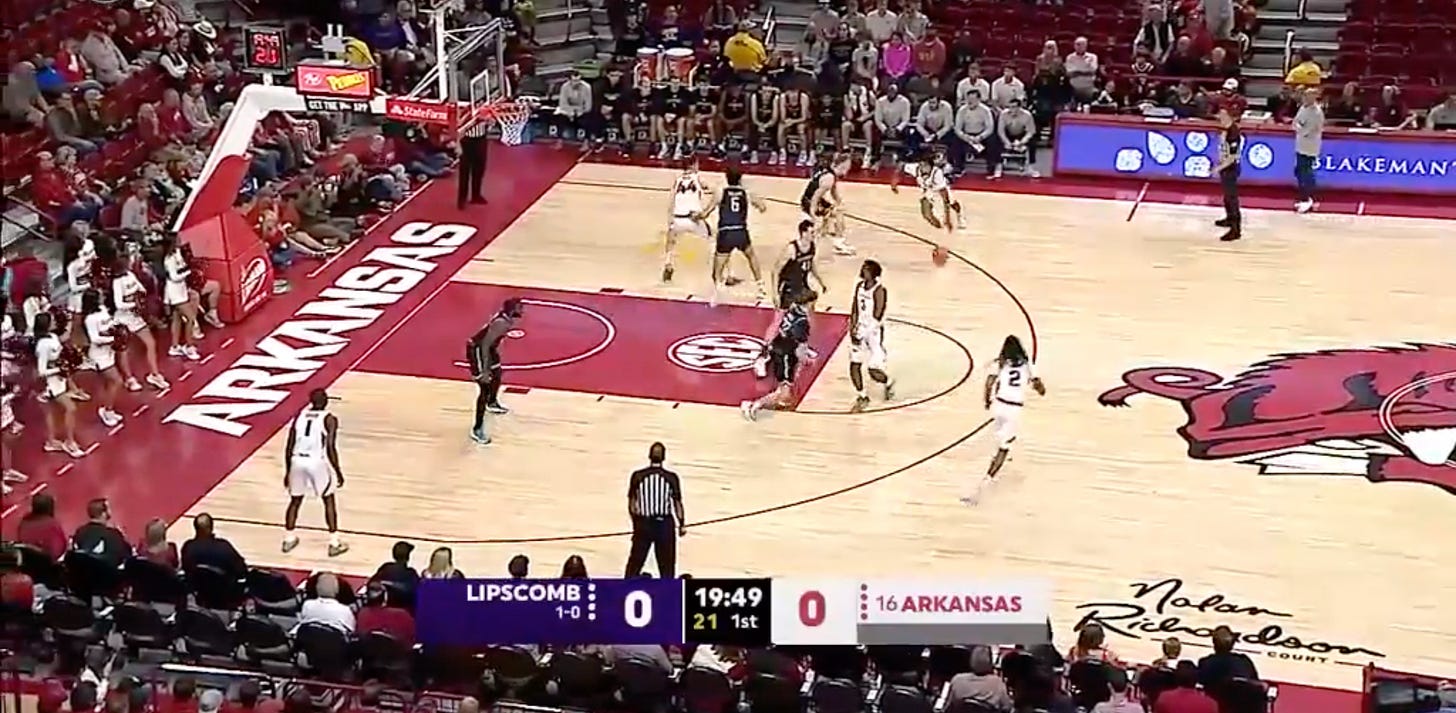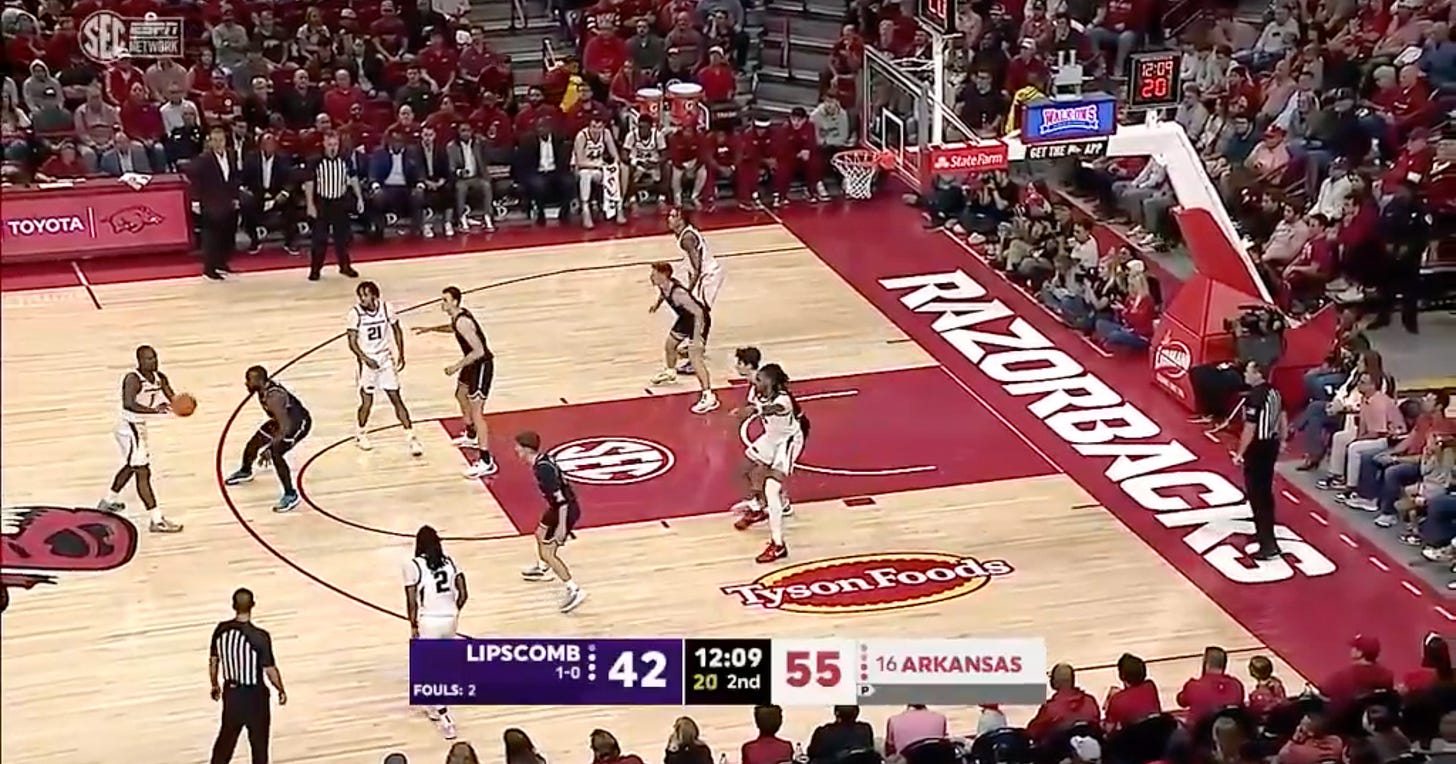NOTE: There is a piece on ball reversals coming next week; for obvious reasons I got sidetracked. Here’s this instead, on something I noticed during the two Arkansas games I’ve seen so far. -WW
A tale as old as time is the existence of the hallowed Trolley Problem, originated by philosopher Judith Thomson in the 1970s. You have probably seen some version of this somewhere in your lifetime. This is one:
There are alternate versions titled the Prisoner’s Dilemma Trolley Problem:
Or there is my personal favorite, in which New York Giants quarterback Daniel Jones is asked by a reporter for his answer to the quandary. Obviously, this is not real, but it is a strong contender for my favorite piece of media of 2024.
 Tiktok failed to load.
Tiktok failed to load.Enable 3rd party cookies or use another browser
But this year’s Trolley Problem, at least in the context of the college basketball season, may belong to Arkansas. I watched the Razorbacks, who are inarguably one of the most interesting teams in college basketball this year, play an exhibition against TCU and a real game against Lipscomb. They went 1-1 in these - a close loss to TCU, a perfectly fine win over a Lipscomb team that I think is 14 or 15-seed quality at year’s end if they win the ASun.
On the respective surfaces, neither game tells us much. Arkansas had a weak offensive performance against a TCU team most have somewhere around the 41-50 range, but in a vacuum, 0.92 PPP and a 51% hit rate on twos isn’t bad, particularly if TCU ends up having a very good defense. Likewise, 1.03 PPP looks kind of bad against a Lipscomb defense we know isn’t good, but one-off performances are rarely much to read into. Besides, in three games - two fake, one real - Arkansas has shot 62% from two and their defense has held all three opponents to legitimately poor (for them) outings.
Those are good things. The reason you’re reading this article today, obviously, is that there are bad things. Arkansas has played three games - two fake, one real. In said three games, they’ve shot 17-67 (25.4%) from three. That is a small sample size. A scarier thing to me: in three games, Arkansas has posted an OREB% of 21.2%, 22.9%, and 20%. Their Shot Volume, which we established last year was (100 - TO% + OREB%), is 104.5 on offense right now.
That’s survivable when you’re hitting shots, but the problem is that Arkansas largely isn’t. Arkansas doesn’t make jumpers, at least not much thus far, and they don’t generate second chances. How do you score? Well, simple: generate as many points off of defense as you possibly can. If you watched the Lipscomb game it probably felt like you saw this exact thing 10 times:
One story from the first game of the Razorback Calipari era is Arkansas got 18 shots off in the first ten seconds of the shot clock and made 17, including going 14-15 at the rim, per Synergy. Arkansas defeated Lipscomb because they scored an absurd 25 points off of 19 Lipscomb turnovers compared to Lipscomb scoring 13 off of Arkansas’s 12. Everything else, more or less, was pretty equal. Except for the fact that most half-court Arkansas possessions had this look from Lipscomb:
It’s not a true packline, but frequently, no one on Lipscomb’s defense would come close to touching the three-point line defensively. On occasion they would sink a little bit deeper, as such:
Or even here, where it almost looks like a double post-up, though this ends up being just a post-up for Jonas Aidoo:
Three key differences are seen here. The top image features a smaller, more flexible lineup with Trevon Brazile as the nominal center, which generally featured 6’6” Karter Knox or 6’8” Adou Thiero at PF. The second image is with Zvonimir Ivisic, the 7’2” giant who can shoot but generally prefers to use his size inside. Ivisic lineups had Thiero or Brazile at PF. The third image features a frontcourt of Brazile and Tennessee transfer Jonas Aidoo, who almost never takes a shot beyond 15 feet.
Therein lies the rub.
While a fine rebounder who had a good game in that aspect, Brazile is a below-average rebounder for a 6’10” guy, but is easily the most threatening offensive piece of the three. Ivisic is significantly better as a post presence and rebounder but is a middling defender. Aidoo is a terrific rim protector and excellent rebounder, but in year four, he still has never delivered on the high school offensive promise he showed and didn’t attempt a single three after MLK Day last year for Tennessee.
With the backcourt packages Arkansas possesses, it makes for a truly fascinating push-and-pull that offers no perfect solution and may be the upper limiter on Arkansas’s offensive potential this year. Because while Arkansas can really score in transition, any time Lipscomb (and TCU) got them to slow down into a half-court setting, it was a pretty scary story to watch unfold.









